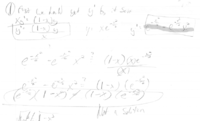mlw19mlw91
New member
- Joined
- Mar 16, 2019
- Messages
- 2
guys here's my problem

I start by dividing everything by X to get y' by itself
I get

(is this the problem?)
then I take the derivative of the Y that he gave us, wich was the y+xe^((-x^2)/2)
and I get the following:
e^{-(x^2}/{2}}-e^{-{x^2}/{2}}x^2
now I put this on the left hand side of the equation, and I get something like this:

then then I plug in the y that he originally gave us, I can not end up with a true statement.
Here's my work on paper, and please forgive me for the messiness:


I start by dividing everything by X to get y' by itself
I get

(is this the problem?)
then I take the derivative of the Y that he gave us, wich was the y+xe^((-x^2)/2)
and I get the following:
e^{-(x^2}/{2}}-e^{-{x^2}/{2}}x^2
now I put this on the left hand side of the equation, and I get something like this:

then then I plug in the y that he originally gave us, I can not end up with a true statement.
Here's my work on paper, and please forgive me for the messiness:

